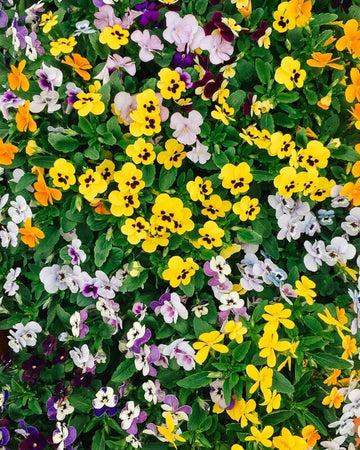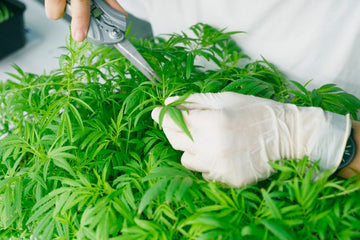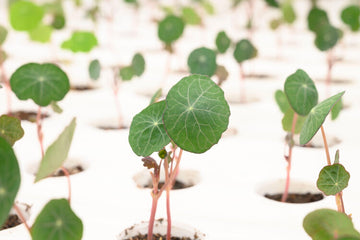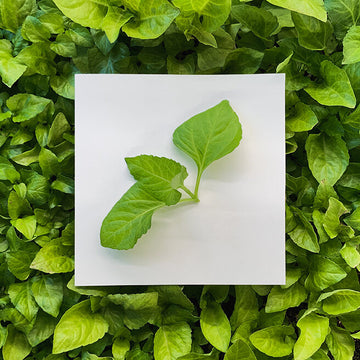
Did you know?
There are over 500 different species of Viola!
Violas have prominently featured in myths, legends, and Shakespeare’s plays.
Violas have long been used medicinally to treat:
- skin conditions such as eczema and itchiness
- bronchitis and whooping cough
- rheumatism, cystitis, and urination difficulty
Also known as: Heart's Delight, Tickle-My-Fancy, Jack-Jump-Up-And-Kiss-Me, Three Faces In A Hood, or Love-In-Idleness
History
The viola has a rich history, featuring in the myths and medicinal practices of its native Eurasian continent, where it can be found growing wild among the grasslands and plains. In Roman mythology, Cupid struck the flower with one of his arrows, giving it the powers of a love potion. Shakespeare used a viola derived magical potion to induce his characters' love inspired madness in A Midsummer's Night Dream.
It's easy to see why this pretty flower has inspired such common names as heartsease, heart's delight, tickle-my-fancy, Jack-jump-up-and-kiss-me, come-and-cuddle-me, three faces in a hood, or love-in-idleness.
How Do You Use Violas?
Our favorite part about violas (and the only reason we grow them ourselves) is that they're edible! Both the leaves and flowers can be added to salads for pops of color and flavor, or used as delicate garnishes on almost any type of dish. They're often used to decorate cakes and other baked goods due to their manageable size and wide range of colors and patterns. We've even candied them for frosting, and molded them into lollipops.
Medicinal Uses
Viola has long been used for its medicinal properties. Some of its possible uses include:
- external application for skin conditions such as eczema, due to its anti-inflammatory and purifying properties
- established diuretic action means it can help treat rheumatism, cystitis, and urination difficulties
- can be used to treat bronchitis and whooping cough, due to its expectorant properties
- an interesting scientific study has found that different color violas can have different nutritional composition, with white and yellow violas having the highest percentage of proteins and antioxidants, while red violas contained the highest amount of carbohydrates and carotenoids Link
*Important Note on Edibility and Medicinal Use: Do not eat violas bought in flower shops! They may have been sprayed with toxic pesticides. Only eat leaves and flowers that you've grown yourself. Get in touch if you would like to buy seeds or flowers from us, we NEVER use pesticides. All our products are produced in an indoor, climate-controlled environment and are 100% safe for consumption. Source for medicinal uses. Not to be used in the place of doctor prescribed medicine.
How to Grow Violas

Planting
- if outdoors, plant during cool, early spring weather- sprinkle seeds onto the soil and gently rake to very lightly cover them
- if indoors, plant a few seeds per pot in any season and lightly cover with a thin layer of soil
- see 1st picture for approx. spacing in a large planter, and 2nd picture for what it will look like in full bloom
Soil & Fertilization
- well-drained, nutrient-rich soil, can be supplemented with organic compost
- slow-release fertilizer in spring and then late summer to produce fall bloom
- do not add too much fertilizer or the stems will grow leggy and weak, best to add during and after flowering
Water
- water regularly, but allow the soil to dry before watering again
- will bloom best with consistent watering
- do not let the soil remain soggy or the roots may develop root rot
Light
- tolerates most conditions
- enjoys sun, but not heat
- full sun during cooler spring temperatures, partial shade during hot summer months
- can be kept indoors in a sunny windowsill

Pruning
- cutting dead blossoms will promote more flowering
- trim leggy stems to allow plants to regrow into shorter, fuller forms
Pests & Diseases
- can attract aphids and slugs
- do not use chemical pesticides if you plan to eat the flowers or leaves
- susceptible to rot and mildew, which can be addressed by proper watering techniques
- susceptible to iron deficiency, which can be corrected with appropriate fertilization







